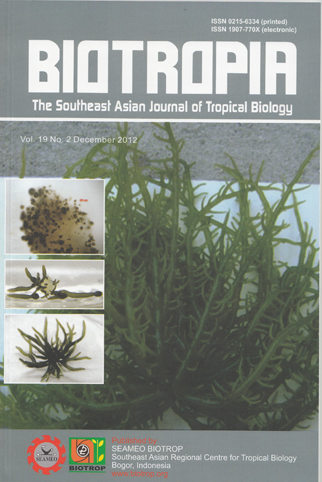
Tags
Mitochondrial DNA variation of the Sumatran elephant in Sumatera
Content Language : English

A research on Mitochondrial DNA analysis of genetic diversity in Sumatran elephant (Elephas maximus sumatranus) was conducted in this study. A 630 bp segment of mitochondrial DNA was amplified on 105 samples of Sumatran elephant from 5 locations in Sumatera (Bentayan, Sugihan, Bukit Salero Lahat, Seblat, Way Kambas) using a set of primers: MDL3 (5’-CCCACAAT-TAATGGGCCC-GGAGCG-3’) and MDL5 (5’-TTACATGAATTGGCAGCCA-ACCAG-3’). The objectives of this study is to generate mitochondrial DNA D-loop sequences for all the Sumatran elephant samples under this study and to provide information haplotypes and nucleotide diversity of Sumatran elephant populations.
A total of 105 PCR product were successfully sequenced perfectly, with an average length of about 616 base pairs. However, mitochondrial DNA fragments for this analysis used the first 601 bases. Results showed six haplotypes (BP, BT, BS, BR, BX and BY) identified in Sumatera. The most of the sampled individuals are the haplotipe BT. BX and BY are most likely new haplotypes.. All haplotype, except for the haplotipe BP are belonging to the Sumatera clade. The haplotipe BX was derived from the haplotipe BT, and the haplotype BY was derived from the haplotipe BS by one transversion respectively. The other substitutions in this network were the transitions. The haplotype BP is widely distribute from Sri Lanka, Sumatera, Peninsular Malay and China). Although reported that the haplotype BU distributed Sumatera and Peninsular Malay, but BU haplotype not detected in this study.
Genetic distances within populations in Bentayan, Bukit Salero Lahat, Seblat, Sugihan and Way Kambas ranged from 0.0000 - 0003, and the genetic distance between the populations that is 0.0000 - 0. 0022. The distance between haplotypes of Sumatran elephant’s population is low.• The diversity of haplotypes and nucleotide in Sumatera island is low, the highest is in the region of Buki Salero Lahat and, lowest is in Bentayan and Sugihan. Overall, the results of analysis of Fu and Li's F * test statistic indicates that the population of Sumatran elephants in Sumatra is -0.78871, which means there is no inbreeding, but not significant at P> 0:10.

This work is licensed under a Creative Commons Attribution-NonCommercial-NoDerivatives 4.0 International License.
